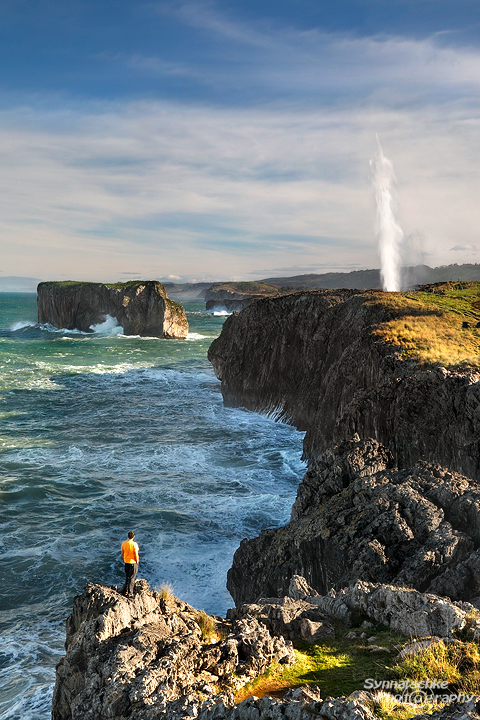
"Bufones", the fantastic blowholes at the Spanish Coast
The cliffs and beaches of eastern Asturias near the border to Cantabria offer some of the most spectacular coastal sceneries in Spain. This is where the immense karst system of the "Picos de Europa" meets the ocean and where the limestone beds - largely composed of soluble calcium-carbonate - are weathered out by waves. Seawater slowly dissolves the rocks, creating innumerous cracks, fractures, fissures, crevices, sinkholes and tunnels. And - as the cavities expand and link to each other - an underground drainage system is formed. As soon as openings on the surface get connected through a vertical shaft to underground caves and to the sea, the wave action might become clearly noticable even at a considerable distance from the cliffs.
In Asturias those kind of openings are called "Bufones". The name derives from the Spanish word "bufido", the "angry snort of an animal". And that's quite a good way to describe the scenery during high tide. Violent waves can build up enough pressure to create strong wind gusts coming apparently "out of nowhere", accompanied by some spray and by a loud noise that might scare the hell out of you. ;-)
During stormy weather, things gets even wilder: The seawater rushes into the underground caves and gushes out of the blowholes with great force, producing large fountains of water resembling a natural geyser (as shown in this animated gif).
This month's image was taken now in early January during our short New Year's trip to Northern Spain. It shows Steffen standing at the edge of the cliffs with an impressive bufón bursting out in the background. The day before, we weren't even able to get near to this place. The storm gale with wind speeds up to 100 km/h would have easily blown us off the "acantilados" (high cliffs) and the spray from the churning sea was so intense over there, that we got instantly soaked even 100 m away from the crashing waves. Luckily, the Bay of Biscay was still pretty agitated when the winds slowed down the next day, so that we were finally able to see and shoot some of bufones while they were active. During our last trips we never had any stormy conditions and all they did was just "roar a bit".
Rough sea and powerful waves are mandatory for this fantastic natural spectacle. And you should also have "marea alta" (high tide), so do not forget to check the tide tables of LLanes before heading out there. The highest concentration of blowholes is located east of Ribadesella at the "Campo de Bufones de Pría" (pretty easy to access from the Autovia del Cantábrico AP-8, Exit #312) and more to the east there is the Bufón de Ballota (near Cué) as well as the Bufones de Arenillas (near Vidiago). The Bufón de Santiuste east of Buelna is the largest of them all, throwing its waters 40 m (130 ft) and more up into the sky at times! This place and the blowholes at Arenillas were declared national monuments back in 2001.
When we did some research on this topic, we wondered why the Spanish Bufones are so unknown and rarely mentioned anywhere. Countless superlatives are used to promote the "sea based" blowholes in all other parts of the world. The most famous of them are found in Hawaii (Nakalele Point, Maui Island), in Sri Lanka (Hummanaya Blowhole, Kudawella), in Australia (Kiama Blowhole, New South Whales) and in Samoa (Alofaaga Blowholes, Savai’i Island). But interestingly all of them do not surpass the heights of 30 m (100 ft) and therefore none of them reach as high into the sky as the Asturian blowholes.
Please be careful: During high tide and stormy conditions standing at the cliffs or right next to the bufones can be life-threatening as you can easily see in this video or this one, both taken from the parking lot at the "Área Recreativa de Guadamía" at the west side of the river. And here is another video showing the Bufones the Pría taking action, also from the bird's-eye view.
But also during calm weather and low tide this part of the Asturias is well worth paying a visit. It is a treasure trove of hidden gems. In some places the razor-sharp, jagged spires and pillars create a moonscape resembling a (very tiny!) miniature version of China's or Madagascar's famous Stone Forests. And more stunning geologic features can be found practically around every corner, wildly sculptured amphitheaters and natural sea arches along with caves only accessible at low tide full of colourful formations.
We appreciated our winter trip to the Spanish Coast very much and we started 2018 in the best possible way: Shooting the rugged cliffs at sunrise on New Year's Day, feeling the sea breeze and enjoying surprisingly mild temperatures (up to 22°C!).
We would like to wish you all a HAPPY & HEALTHY 2018!
Isabel & Steffen
Image data: 1/20 s at f/16, ISO 200; Canon EF 24-104 mm at 47 mm, Canon EOS 5D Mark IV
